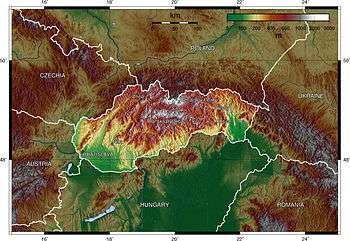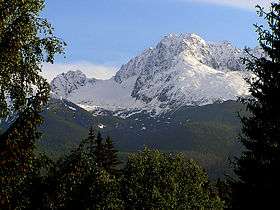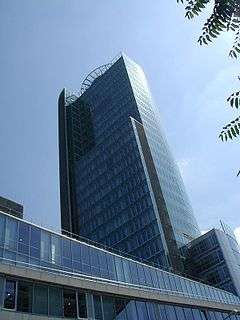Geography of Slovakia

Slovakia is a landlocked Central European country with mountainous regions in the north and flat terrain in the south.
Area

Slovakia lies between 49°36'48" and 47°44'21" northern latitude and 16°50'56" and 22°33'53" eastern longitude.
The northernmost point is near Beskydok, a mountain on the border with Poland near the village of Oravská Polhora in the Beskides. The southernmost point is near the village of Patince on the Danube on the border with Hungary. The westernmost point is on the Morava River near Záhorská Ves on the Austrian border. The easternmost point is close to the summit of Kremenec, a mountain near the village of Nová Sedlica at the meeting point of Slovak, Polish, and Ukrainian borders.

The highest point is at the summit of Gerlachovský štít in the High Tatras, 2,655 m (8,710.6 ft), the lowest point is the surface of the Bodrog River on the Hungarian border at 94 m (308.4 ft).
The country's area is 48,845 km2 (18,859 sq mi). 31% is arable land, 17% pastures, 41% forests, 3% cultivated land. The remaining 8% is mostly covered with human structures and infrastructure, and partly with rocky mountain ridges and other unimproved land.[1]
Slovakia borders Poland in the north - 547 km (339.9 mi), Ukraine in the east - 98 km (60.9 mi), Hungary in the south - 679 km (421.9 mi), Austria in the south-west - 106 km (65.9 mi), and the Czech Republic in the north-west - 252 km (156.6 mi) for a total border length of 1,672 km (1,038.9 mi).[2]
Human geography
Economic geography

The gross domestic product was 1.66 trillion Slovak korunas in 2006, equal to around 50 billion euros or 71 billion USD,[3] which is around 8,800 Euro or 13,000 USD per capita.
GDP per sector:[4]
- Agriculture 3.6%
- Industry (raw materials, production, energy, water) 31.6%
- Services 64.8%
The western regions are more developed than the eastern ones. As of 2004, the highest GDP per capita was 573,976 SK in the Bratislava Region, which was more than double of the national average (251,814 SK). That statistical area comprises only the city of Bratislava, which distorts Slovak regional and regional-international comparisons. The GDP per capita was 152,786 SK in the Prešov Region in the north-east, 60% of the national average.[5]
Agriculture
Cultivated fields occupy around 29% of Slovakia. Principal crops are wheat, barley, maize, sugar beets and potatoes. Viticulture is widespread in the southern areas, mainly around the Little Carpathians, Danubian Lowland and Tokaj area. The breeding of livestock, including pigs, cattle, sheep is also practiced.[6]
Industry
Slovakia was partly industrialized in the 19th century, but became an industrialized country in the second half of the 20th century. The Communist government emphasized heavy and arms industry. After Velvet Revolution and independence from Czechoslovakia in 1993 it somewhat declined; today, main sectors are manufacturing, electrotechnical, chemical, petrol, steel, textile and food processing industries. In recent years the car-making industry is on the rise, with car plants built in Bratislava, Trnava and Žilina. Other important industrial towns are Trenčín, Prešov and Košice.
Energy

Fossil fuels, particularly oil and gas, are imported. In 2004, the most important source of energy was from nuclear power plants (55.7%), located in Jaslovské Bohunice and Mochovce. Another source of energy was from hydroelectric plants (13,9%), with the main one being the Gabčíkovo Dam on the Danube and other on the Váh, Slaná, the Orava and the Hornád rivers; other sources were coal (10,9%), natural gas (7,9%), and oil (2,4%).[7] In 2005 Slovakia consumed 24.93 billion kWh of electricity.[4]
Transport
Road transport
The road network in Slovakia is composed of 42,696 km roads (except highways and expressways), of which 3,341 km were first-class roads, 3,734 km second-class roads, 10,401 km third-class roads and 25,220 km local roads in 2000.[8] As of September 2012, there were 415 km of highways and 258 km of expressways.
Rail transport
The railway network includes as of 2006 3,662 km of railways, of which 3,512 km were in 1,435 mm (4 ft 8 1⁄2 in) standard gauge, 100 km in 1,520 mm (4 ft 11 27⁄32 in) Russian gauge and 50 km in 1,000 mm (3 ft 3 3⁄8 in) metre gauge or 750 mm (2 ft 5 1⁄2 in) (narrow gauge).[4] There are significant links from Bratislava to the Czech Republic, Austria and Hungary and the most important line in the country is from Bratislava to Košice via Žilina.
Water transport
The main Slovak waterway is the Danube, with 172 km. Other navigable rivers are lower parts of Váh, and few kilometres of Bodrog. Main ports are located in Bratislava and Komárno.
Social geography
Around 5,391,000 people lived in Slovakia at the end of 2006. According to the 2001 census, 85.8% of the people were of Slovaks, 9.7% Hungarians, 1.7% Roma, 0.8% Czechs, 0.4% Rusyns, 0.2% Ukrainians and others.[9]
Approximately 5,600 people immigrated into Slovakia in 2006, while 1,700 emigrated from Slovakia. There were 53,904 live births (fertility rate 1.24) and 53,301 deaths (9.9 deaths per 1000 inhabitants) (2006).[10]
The average population density in Slovakia was 110/km². There are noticeable, but not extreme differences between regions. The most populous areas are Bratislava and vicinity, the Danubian Lowland, the lower and central Váh Valley, and the agglomeration around the cities of Košice and Prešov. The least populous areas are the mountainous regions of central Slovakia and the north-east. The density is below 50-70/km² in some districts.
Climate
References
- ↑ bedekr.cz
- ↑ Slovak Wikipedia: sk:Slovensko#Hranice
- ↑ Statistical Office of the Slovak Republic
- 1 2 3 CIA World Factbook
- ↑ Regional Gross Domestic Product per head at the Statistical Office of the Slovak Republic
- ↑ "Slovakia at MSN Encarta". Archived from the original on 2009-10-31.
- ↑ (German)
- ↑ Slovak Roads Administration
- ↑ http://portal.statistics.sk/files/Sekcie/sek_600/Demografia/SODB/Tabulky/Tabulky_AJ_SODB/tab11.pdf
- ↑ Statistical Office of the Slovak Republic
| Wikimedia Commons has media related to Geography of Slovakia. |

